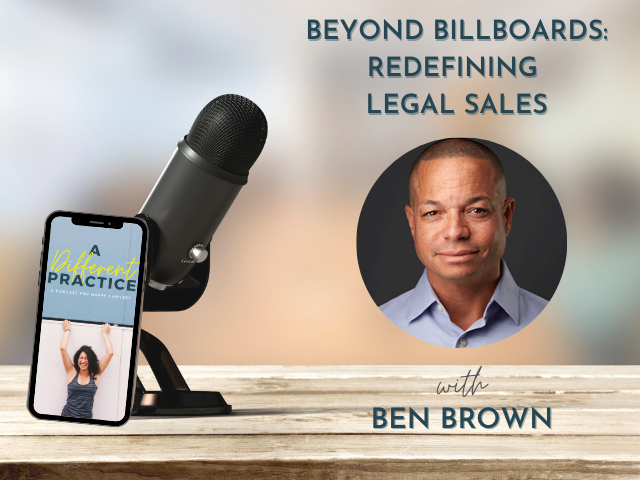When chatting with fellow colleagues, we often say and hear these frustrations:
- “My client calls me three times a day and is driving me crazy!”
- “My client stopped paying me and now I’m working for free!”
- “This case is killing me. I don’t do family law but took this case because I needed the money.”
- “My client has unreasonable expectations and is impossible to satisfy.”
If you haven’t experienced these frustrations, you’ve probably heard of them. We tend to place the blame for these frustrations on them; It’s the client’s fault they stopped paying, right? And it’s the client’s fault their expectations are totally whack, right? While it’s true the client bears some responsibility, usually, this is an “us” problem, not a “them” problem. Let me explain using each example above.
“My client calls me three times a day and is driving me crazy!”
I agree this is super annoying, not to mention a major time suck. But why are you letting them continue to do that? And more importantly, why did you let them start doing it in the first place? Usually, it doesn’t occur to us to set expectations regarding communications upfront because we assume it won’t be a problem. But we’ve all had it become a problem. Keep reading, we’ll talk more about this in a minute.
“My client stopped paying me and now I’m working for free!”
That’s the worst! But again, how did this happen, and why is it persisting? Most of us don’t like talking about money with clients and usually avoid the conversation altogether. This is a huge mistake and a missed opportunity to offer a customized solution. At some point during the initial consultation, we need to ask the potential client how much money they have to spend on a solution to their problem. Then offer them options that fit within their budget. To offer this individualized approach, we may need to unbundle services or offer payment plans. (If you unbundle services, be sure to meet your state’s requirements for doing so.) If a potential client tells us that they only have a certain amount budgeted for a solution and it’s not enough to cover our full range of services but we agree to provide the representation anyway, we don’t have anyone else to blame but ourselves. And if the client initially said they had the money but then stopped paying, we first need to have an honest conversation about the situation. If they are unable or unwilling to resolve the issue, it’s time for us to terminate the engagement and withdraw. Remember, we are here to provide a service but that doesn’t mean we are married to any particular client.
“This case is killing me. I don’t do family law but took this case because I needed the money.”
Have you heard the saying “The bad client or case you don’t take will be the best money you never made.” It’s so true! Although it’s something we can easily lose sight of and need to remind ourselves often. Although it’s hard, we need to resist the urge to dabble outside of our practice areas. Instead, it would benefit our businesses more to use the time to focus on the clients we have or want to have and provide exceptional service to them.
“My client has unreasonable expectations and is impossible to satisfy.”
Usually, one of two things happens here. Either, we didn’t do a great job of discussing expectations during the initial consultation or the client expressed his or her unreasonable expectations but we took the case anyway. The good news is the former is easy to correct. We just need to start discussing the client’s goals and setting expectations from the initial contact. If it’s the latter, we need to repeat the mantra above: “The bad client or case you don’t take will be the best money you never made.”
Screening clients and setting expectations are two highly underrated but critical skills needed to be profitable. Having a good business model and pricing menu will start you on the right path, and creating good client screening skills will help you create a profitable practice.
Developing good client screening skills
Being thoughtful at the outset and then putting into practice your thoughtfulness will help develop screening skills. Start by creating a case acceptance guidelines and identify potential red flags before the first case walks in the door. If you are already taking cases, that’s okay! Today is a great day to implement your guidelines going forward. You might be surprised how quickly you notice the results! Below are some ideas to get you started.
Case Acceptance Guidelines & Red Flags
Here are some questions you might consider during the initial consultation:
- Am I comfortable with this kind of legal work? If not, do I have the time and desire to become competent in the relevant practice area?
- Do I feel comfortable with this potential client?
- Are there personality clashes between me and the potential client?
- Are the potential client’s goals and expectations reasonable?
- Can the client afford the amount of work necessary to accomplish their goals? If not, consider offering unbundled legal services, if appropriate, and see the CBF/JEP Limited Scope Toolkit for additional screening tips.
- Do I have the necessary time to commit to the matter?
- Has the potential client left me with enough time during which to provide competent assistance or has the client come with a last-minute emergency?
- Am I the first lawyer with whom the potential client has consulted regarding the potential representation? If not, delve into why. If payment is the issue, that might be something you can customize around. If it’s because the client is uncooperative or has unrealistic expectations, you should consider declining the case.
- Will I be able to verify the potential client’s material facts of the case?
- Is the potential client able to focus on legal outcomes after I have explained them or does he or she seem more focused on revenge?
- Does the potential client seem open to discussing and agreeing to fees?
- Does the client speak the same language as me? If English is not the potential client’s first language and you do not also speak the potential client’s first language, it is important that you hire an interpreter for all parts of the case so that the potential client fully understands the limitations of the representation (if any) and what that means for them.
In addition to asking yourself these questions as you evaluate a potential client (PC) and their case, be on the lookout for the following red flags:
- The PC is non-communicative
- The PC lacks follow-through (Tip: consider having a system in place to determine this upfront, like a homework assignment.)
- The PC is a perpetual victim
- The PC is spouting out legal conclusions
- The PC is telling you what to do
- The PC lacks truthfulness
- The PC is overly emotional
- You’re gut feeling – most important!
It’s important to note that none of the case acceptance guidelines or red flags above will likely be deal-breakers on their own. If the red flags accumulate though, you might not want to take the case.
Setting client expectations at the outset
Setting client expectations is a relatively easy step in the acquisition and onboarding process, but because it’s so easy, we often skip it, thinking it’s a given. Take a moment and think of the ways you are currently setting client expectations. If you aren’t sure, that’s a great opportunity because it means you can start building a solution today. Let’s tackle it from the different phases: before, during and following the initial consultation.
Before the initial consultation
Ideally, we’d screen consumers who aren’t a good fit for our practice and set expectations for the ones who are before the potential client even makes their first contact with us. If we reconsider the issue of “My client has stopped paying me and I’m working for free”, what are some ways we could set expectations about the cost of services before the customer ever calls? One option is to list prices or price ranges on your website. Listing pricing on our websites helps consumers decide upfront whether they can afford our services, not halfway through the representation when it’s too late.
During the initial consultation
The main goal of the initial consultation should be setting expectations. In addition to setting a client’s expectations about their case (the steps involved and associated timelines), we should also set expectations around the service itself. This is where communication comes in. It’s important to identify and summarize the level of communication the client desires and convey whether or not you are able to meet those expectations. If you can meet their needs, discuss and outline in the engagement agreement how communication will work and what the boundaries are. Having expectations in writing will allow you to refer back to them when things aren’t going as expected.
If you decide you are unable to meet the client’s communication needs, you will provide the best level of service by referring them to someone who can meet those needs. Have a referral list ready so it’s easy to provide when needed.
After the initial consultation
After the initial consultation, the next few interactions with the client provide opportunities to reiterate the expectations of the engagement and establish a strong foundation for moving forward. Interactions can be anything from an email, phone call, or follow-up meeting. Think about your client intake process. What is the first interaction after the initial consultation? How can it continue to set expectations? One option could be to send a standard welcome email that provides the client with a high-level overview of milestones, a timeline, a copy of the engagement agreement, and clearly identified next steps.
Next steps
Developing good client screening and expectation setting skills takes practice, and no procedure will ever completely eliminate issues. Implementing acceptance guidelines and being thoughtful about setting expectations before, during and after the initial consultation, however, will dramatically decrease frustrations.
What do you do now to screen potential clients? How do you set expectations? What challenges have you faced in the past and what can you do to address them going forward? Consider including your staff in this discussion; they likely have different perspectives and great ideas!





